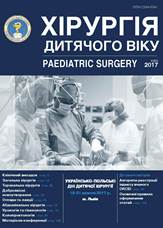Diagnostics and choice of surgical approach for treatment of children with digestive tract duplication
DOI:
https://doi.org/10.15574/PS.2017.57.53Keywords:
duplication, digestive tract, diagnostics, treatment, childrenAbstract
Objective: to develop rational diagnosis and the effective choice of methods for surgical treatment of digestive tract duplication (DTD) in children.Material and methods. From 1981 to 2016, we treated 59 children with DTD, aged 6 months to 18 years. Cystic type duplication was detected in 44 (74.58%), diverticular type – in 9 (15.25%) and tubular type – in 6 (10.17%) patients.
Results and discussion. All children underwent surgical treatment depending on the localization of the duplicate. In duplication of thoracic part of the esophagus, thoracotomy (n=3) and thoracoscopy (n=2) was performed for the removal of duplication. In children with the abdominal esophageal duplication, for removal of the duplication laparotomy (n=5), laparoscopy (n=2), Nissen (n=5) and Thal (n=2) fundoplication were performed. Children with duplication of the stomach, removal of duplication and suturing of the defect was performed using laparotomy (n=8) or laparoscopy (n=4). With cystic duplication of the stomach and duodenum, Bilroth-1 resection of the stomach (n=1) and subserosum removal of the cystic duplication with the defect suturing (n=2) was used. With duplication of the duodenum (n=7), the cysts were removed with suturing of the wall defect. With long forms of duplications of the small intestine (n=8), it was considered expedient to perform an economical resection of the intestine, together with duplication and endtoend anastomosis. With short forms of duplications (n=3), the wedge-shaped resection of intestine was performed. In one child using the enucleation of the small intestine duplication had good results. In case of the terminal ileum (n=1) and ceacum duplication (n=2), the resection of duplication with invaginative ileiocoloanastomosis was used. All patients with duplication of the colon and rectum (n=9) underwent the stage surgical treatment with the affected area removal. Long term results in all patients were good. Children are practically healthy with good quality of life.
Conclusions. DTD is a rare surgical congenital defect, the final diagnosis of which is established during the operation. Duplication occurs in various sections of the digestive tract, most often in the colon (22.03%), in the stomach and small intestine (20.34%); to a lesser degree in the esophagus and duodenum. The cystic type of duplication is typical for 74.28%, diverticular for 15.25%, and tubular for 10.17% of children with this anomaly. Clinical symptoms of duplication in children depend on the level and length of affected part of the digestive tract. The most rational and effective methods for diagnosis of duplications of various sections of the digestive tract in children is ultrasound with Doppler, CT and MRI. The type of surgical intervention in children with DTD depends on the localization, size and anatomical structure of duplication.
Downloads
Issue
Section
License
The policy of the Journal “PAEDIATRIC SURGERY. UKRAINE” is compatible with the vast majority of funders' of open access and self-archiving policies. The journal provides immediate open access route being convinced that everyone – not only scientists - can benefit from research results, and publishes articles exclusively under open access distribution, with a Creative Commons Attribution-Noncommercial 4.0 international license(СС BY-NC).
Authors transfer the copyright to the Journal “PAEDIATRIC SURGERY.UKRAINE” when the manuscript is accepted for publication. Authors declare that this manuscript has not been published nor is under simultaneous consideration for publication elsewhere. After publication, the articles become freely available on-line to the public.
Readers have the right to use, distribute, and reproduce articles in any medium, provided the articles and the journal are properly cited.
The use of published materials for commercial purposes is strongly prohibited.

